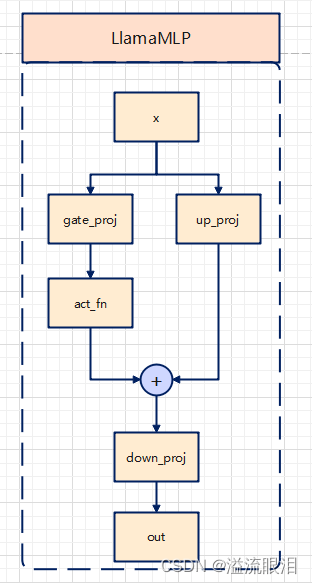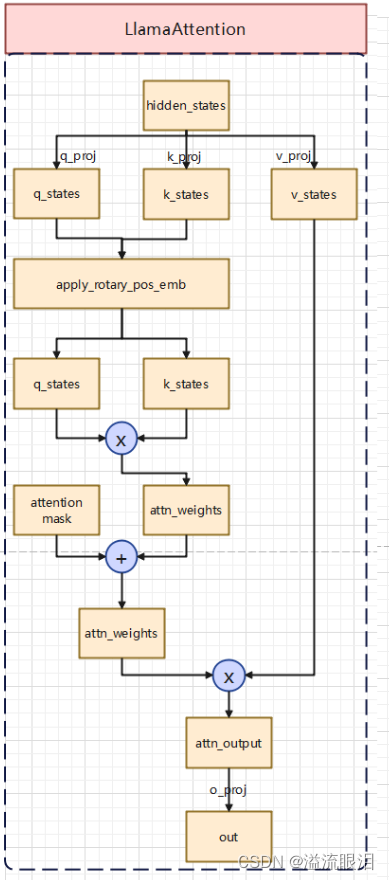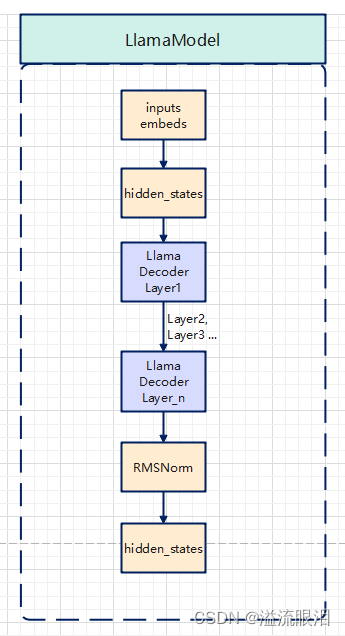【Python】科研代码学习:十六 Model与网络架构 的代码细节:Llama 为例(v4.28.0)
前言
- 【Github:Transformers/llama】
接下来就是重头戏,我如何修改嵌入层?MLP层?注意力层?解码层?
前向传播的逻辑如何实现与修改?
损失如何设置和得到?
就看modeling_llama.py这个重要脚本了
(在 Github中,请找到自己对应模型的脚本,并建议自己打开来看一看源码)
※ 本文使用的版本为v4.28.0,不同版本的源码会有所不同。 - 整理完的架构图如下:

导入依赖
- 代码一共八百多行,一口气看完不现实,我们按照功能分区,一块一块了解
第一步其实是查看代码的导入依赖,这样可以更好了解我们后续代码用到了什么,需要什么
首先是一些基础的工具包math, typing
然后是使用torch实现的网络架构,而不是tensorflow / Flax
其次,后面的...表示的是上级的包中的代码,也就是说这些代码都是这个Github中自己实现的代码了
activations肯定是设置了激活函数
modeling_outputs设置了模型的输出
带有utils字样的都是功能代码,不用大在意,就发现他用了PreTrainedModel, logging等类
然后还用了LlamaConfig - 如果想很细致的学习的话,做包依赖图有时候可以帮助理清很多代码之间的逻辑。
""" PyTorch LLaMA model."""
import math
from typing import List, Optional, Tuple, Union
import torch
import torch.utils.checkpoint
from torch import nn
from torch.nn import BCEWithLogitsLoss, CrossEntropyLoss, MSELoss
from ...activations import ACT2FN
from ...modeling_outputs import BaseModelOutputWithPast, CausalLMOutputWithPast, SequenceClassifierOutputWithPast
from ...modeling_utils import PreTrainedModel
from ...utils import add_start_docstrings, add_start_docstrings_to_model_forward, logging, replace_return_docstrings
from .configuration_llama import LlamaConfig
LlamaRMSNorm:改进的 层正则化
- 【CSDN:Llama 美洲鸵(大羊驼)改进之一:均方层归一化RMSNorm】
LayerNorm:对特征张量进行均值为0,方差为1的归一化操作
RMSNorm (Root Mean Square Layer Norm):对上面的一个改进,可以降低噪声,减少计算时间。
LlamaRotaryEmbedding:旋转式位置编码
- 【知乎:一文看懂 LLaMA 中的旋转式位置编码(Rotary Position Embedding)】
旋转式位置编码(RoPE)是位置编码方式的一种,llama就使用该方式。
位置编码的作用是放置我爱你和你爱我变成一个意思,虽然使用了相同的词,但是位置不一样,所以语义也不同。
详细的数值计算请在上文中感兴趣查看。
这里涉及了q,k,v向量,注意力机制
LlamaMLP:多层感知机(人工神经网络)
- 直接上源码,这个比较短
可以看到这个MLP其实就是三个线性层加上一个ACT2FN的激活函数
一次forward前向的话,先计算gate_proj(x)然后做一次激活函数,然后与up_proj(x)相乘,最后计算down_proj

class LlamaMLP(nn.Module):
def __init__(
self,
hidden_size: int,
intermediate_size: int,
hidden_act: str,
):
super().__init__()
self.gate_proj = nn.Linear(hidden_size, intermediate_size, bias=False)
self.down_proj = nn.Linear(intermediate_size, hidden_size, bias=False)
self.up_proj = nn.Linear(hidden_size, intermediate_size, bias=False)
self.act_fn = ACT2FN[hidden_act]
def forward(self, x):
return self.down_proj(self.act_fn(self.gate_proj(x)) * self.up_proj(x))
LlamaAttention:多头注意力层
- 主要内容是从
Attention is All you need这篇paper来的
它的作用是让从上下文无关的词嵌入到有上下文语义相关的词嵌入。
首先看下初始化,它有q_proj, k_proj, v_proj, o_proj这几个线性层
还有一个rotary_emb这个旋转位置编码工具

def __init__(self, config: LlamaConfig):
super().__init__()
self.config = config
self.hidden_size = config.hidden_size
self.num_heads = config.num_attention_heads
self.head_dim = self.hidden_size // self.num_heads
self.max_position_embeddings = config.max_position_embeddings
if (self.head_dim * self.num_heads) != self.hidden_size:
raise ValueError(
f"hidden_size must be divisible by num_heads (got `hidden_size`: {self.hidden_size}"
f" and `num_heads`: {self.num_heads})."
)
self.q_proj = nn.Linear(self.hidden_size, self.num_heads * self.head_dim, bias=False)
self.k_proj = nn.Linear(self.hidden_size, self.num_heads * self.head_dim, bias=False)
self.v_proj = nn.Linear(self.hidden_size, self.num_heads * self.head_dim, bias=False)
self.o_proj = nn.Linear(self.num_heads * self.head_dim, self.hidden_size, bias=False)
self.rotary_emb = LlamaRotaryEmbedding(self.head_dim, max_position_embeddings=self.max_position_embeddings)
- 接下来,我们看一下
forward的逻辑。
1)首先输入的张量为hidden_states
2)接着把它作为输入,分别进入q_proj, k_proj, v_proj三个层计算后,得到q_states, k_states, v_states
3)然后对q_states, k_states进行旋转位置编码
4)然后计算q_states * k_states(矩阵乘法),得到attn_weights
5)attn_weights与attention_mask相加,做一下softmax操作,然后与v_states矩阵乘得到attn_output
6)attn_output进入o_proj后输出结果即为最终的out - 由于它是序列化数据,对于当前位置的
q_states, k_states我们计算后,可以把它存储到past_key_value=tuple( list[k_states], list[v_states])里面,方便后续直接调用。
def forward(
self,
hidden_states: torch.Tensor,
attention_mask: Optional[torch.Tensor] = None,
position_ids: Optional[torch.LongTensor] = None,
past_key_value: Optional[Tuple[torch.Tensor]] = None,
output_attentions: bool = False,
use_cache: bool = False,
) -> Tuple[torch.Tensor, Optional[torch.Tensor], Optional[Tuple[torch.Tensor]]]:
bsz, q_len, _ = hidden_states.size()
query_states = self.q_proj(hidden_states).view(bsz, q_len, self.num_heads, self.head_dim).transpose(1, 2)
key_states = self.k_proj(hidden_states).view(bsz, q_len, self.num_heads, self.head_dim).transpose(1, 2)
value_states = self.v_proj(hidden_states).view(bsz, q_len, self.num_heads, self.head_dim).transpose(1, 2)
kv_seq_len = key_states.shape[-2]
if past_key_value is not None:
kv_seq_len += past_key_value[0].shape[-2]
cos, sin = self.rotary_emb(value_states, seq_len=kv_seq_len)
query_states, key_states = apply_rotary_pos_emb(query_states, key_states, cos, sin, position_ids)
# [bsz, nh, t, hd]
if past_key_value is not None:
# reuse k, v, self_attention
key_states = torch.cat([past_key_value[0], key_states], dim=2)
value_states = torch.cat([past_key_value[1], value_states], dim=2)
past_key_value = (key_states, value_states) if use_cache else None
attn_weights = torch.matmul(query_states, key_states.transpose(2, 3)) / math.sqrt(self.head_dim)
if attn_weights.size() != (bsz, self.num_heads, q_len, kv_seq_len):
raise ValueError(
f"Attention weights should be of size {(bsz * self.num_heads, q_len, kv_seq_len)}, but is"
f" {attn_weights.size()}"
)
if attention_mask is not None:
if attention_mask.size() != (bsz, 1, q_len, kv_seq_len):
raise ValueError(
f"Attention mask should be of size {(bsz, 1, q_len, kv_seq_len)}, but is {attention_mask.size()}"
)
attn_weights = attn_weights + attention_mask
attn_weights = torch.max(attn_weights, torch.tensor(torch.finfo(attn_weights.dtype).min))
# upcast attention to fp32
attn_weights = nn.functional.softmax(attn_weights, dim=-1, dtype=torch.float32).to(query_states.dtype)
attn_output = torch.matmul(attn_weights, value_states)
if attn_output.size() != (bsz, self.num_heads, q_len, self.head_dim):
raise ValueError(
f"`attn_output` should be of size {(bsz, self.num_heads, q_len, self.head_dim)}, but is"
f" {attn_output.size()}"
)
attn_output = attn_output.transpose(1, 2)
attn_output = attn_output.reshape(bsz, q_len, self.hidden_size)
attn_output = self.o_proj(attn_output)
if not output_attentions:
attn_weights = None
return attn_output, attn_weights, past_key_value
LlamaDecoderLayer:解码层
llama等模型,都是主要利用了transformer架构中的Decoder解码层为主题架构
查看初始化中,明显它包含了上述提到的好几个层模块,有LlamaAttention, LlamaMLP, LlamaRMSNorm等- 主要来看前向传播的逻辑
1)首先输入为hidden_states张量,并且取了它一个副本,叫做residual剩余网络
2)hidden_states经过一个LlamaRMSNorm
3)然后hidden_states经过一个LlamaAttention层
4)然后hidden_states与residual剩余网络相加
5)然后重置residual剩余网络为目前的hidden_states
6)hidden_states再经过一个LlamaRMSNorm
7)hidden_states再经过一个全连接层LlamaMLP
8)然后hidden_states与residual剩余网络相加,作为最终输出

class LlamaDecoderLayer(nn.Module):
def __init__(self, config: LlamaConfig):
super().__init__()
self.hidden_size = config.hidden_size
self.self_attn = LlamaAttention(config=config)
self.mlp = LlamaMLP(
hidden_size=self.hidden_size,
intermediate_size=config.intermediate_size,
hidden_act=config.hidden_act,
)
self.input_layernorm = LlamaRMSNorm(config.hidden_size, eps=config.rms_norm_eps)
self.post_attention_layernorm = LlamaRMSNorm(config.hidden_size, eps=config.rms_norm_eps)
def forward(
self,
hidden_states: torch.Tensor,
attention_mask: Optional[torch.Tensor] = None,
position_ids: Optional[torch.LongTensor] = None,
past_key_value: Optional[Tuple[torch.Tensor]] = None,
output_attentions: Optional[bool] = False,
use_cache: Optional[bool] = False,
) -> Tuple[torch.FloatTensor, Optional[Tuple[torch.FloatTensor, torch.FloatTensor]]]:
"""
Args:
hidden_states (`torch.FloatTensor`): input to the layer of shape `(batch, seq_len, embed_dim)`
attention_mask (`torch.FloatTensor`, *optional*): attention mask of size
`(batch, 1, tgt_len, src_len)` where padding elements are indicated by very large negative values.
output_attentions (`bool`, *optional*):
Whether or not to return the attentions tensors of all attention layers. See `attentions` under
returned tensors for more detail.
use_cache (`bool`, *optional*):
If set to `True`, `past_key_values` key value states are returned and can be used to speed up decoding
(see `past_key_values`).
past_key_value (`Tuple(torch.FloatTensor)`, *optional*): cached past key and value projection states
"""
residual = hidden_states
hidden_states = self.input_layernorm(hidden_states)
# Self Attention
hidden_states, self_attn_weights, present_key_value = self.self_attn(
hidden_states=hidden_states,
attention_mask=attention_mask,
position_ids=position_ids,
past_key_value=past_key_value,
output_attentions=output_attentions,
use_cache=use_cache,
)
hidden_states = residual + hidden_states
# Fully Connected
residual = hidden_states
hidden_states = self.post_attention_layernorm(hidden_states)
hidden_states = self.mlp(hidden_states)
hidden_states = residual + hidden_states
outputs = (hidden_states,)
if output_attentions:
outputs += (self_attn_weights,)
if use_cache:
outputs += (present_key_value,)
return outputs
LlamaPreTrainedModel:一个 PretrainedModel 的简单封装
- 接下来,定义了一个
LlamaPreTrainedModel,它继承了PretrainedModel
并额外提供了配置类LlamaConfig和其他一些配置参数
重载了_init_weights初始化权重方法
重载了_set_gradient_checkpointing设置梯度中继点方法
class LlamaPreTrainedModel(PreTrainedModel):
config_class = LlamaConfig
base_model_prefix = "model"
supports_gradient_checkpointing = True
_no_split_modules = ["LlamaDecoderLayer"]
_keys_to_ignore_on_load_unexpected = [r"decoder\.version"]
def _init_weights(self, module):
std = self.config.initializer_range
if isinstance(module, nn.Linear):
module.weight.data.normal_(mean=0.0, std=std)
if module.bias is not None:
module.bias.data.zero_()
elif isinstance(module, nn.Embedding):
module.weight.data.normal_(mean=0.0, std=std)
if module.padding_idx is not None:
module.weight.data[module.padding_idx].zero_()
def _set_gradient_checkpointing(self, module, value=False):
if isinstance(module, LlamaModel):
module.gradient_checkpointing = value
LlamaModel:Llama模型的本体
LlamaModel是继承了LlamaPreTrainedModel,并提供了其他网络参数和网络架构等成员和方法。
从初始化中,能发现它拥有词汇表大小vocab_size(从 config 中获取的)
拥有embed_tokens,即输入的嵌入向量(即已经经过 tokenizer 后的产出)
layers中间层
nrom也是RMSNorm正则化层- 继续看前向传播的逻辑
0)前面许多行都是获取必要的参数,如果获取不到的话,就从 config 里面获取,或者给创建一个默认值
1)设置了hidden_states为输入的inputs_embeds
2)重点是 for 循环中,每一次都进入一个LlamaDecoderLayer,一共进入了num_hidden_layers个这样的解码器层
3)最后的hidden_states经过了一次RMSNorm正则化层
4)如果output_hidden_states = True,那么将all_hidden_states加上最后一个hidden_states
根据return_dict的值,选择返回字典,或者返回一个BaseModelOutputWithPast
里面包含了last_hidden_state(最后隐藏状态),past_key_values(缓存机制,保存最后层的一些输出),hidden_states(全部的隐藏状态),attentions(全部的注意力状态)

class LlamaModel(LlamaPreTrainedModel):
"""
Transformer decoder consisting of *config.num_hidden_layers* layers. Each layer is a [`LlamaDecoderLayer`]
Args:
config: LlamaConfig
"""
def __init__(self, config: LlamaConfig):
super().__init__(config)
self.padding_idx = config.pad_token_id
self.vocab_size = config.vocab_size
self.embed_tokens = nn.Embedding(config.vocab_size, config.hidden_size, self.padding_idx)
self.layers = nn.ModuleList([LlamaDecoderLayer(config) for _ in range(config.num_hidden_layers)])
self.norm = LlamaRMSNorm(config.hidden_size, eps=config.rms_norm_eps)
self.gradient_checkpointing = False
# Initialize weights and apply final processing
self.post_init()
def get_input_embeddings(self):
return self.embed_tokens
def set_input_embeddings(self, value):
self.embed_tokens = value
# Copied from transformers.models.bart.modeling_bart.BartDecoder._prepare_decoder_attention_mask
def _prepare_decoder_attention_mask(self, attention_mask, input_shape, inputs_embeds, past_key_values_length):
# create causal mask
# [bsz, seq_len] -> [bsz, 1, tgt_seq_len, src_seq_len]
combined_attention_mask = None
if input_shape[-1] > 1:
combined_attention_mask = _make_causal_mask(
input_shape,
inputs_embeds.dtype,
device=inputs_embeds.device,
past_key_values_length=past_key_values_length,
)
if attention_mask is not None:
# [bsz, seq_len] -> [bsz, 1, tgt_seq_len, src_seq_len]
expanded_attn_mask = _expand_mask(attention_mask, inputs_embeds.dtype, tgt_len=input_shape[-1]).to(
inputs_embeds.device
)
combined_attention_mask = (
expanded_attn_mask if combined_attention_mask is None else expanded_attn_mask + combined_attention_mask
)
return combined_attention_mask
@add_start_docstrings_to_model_forward(LLAMA_INPUTS_DOCSTRING)
def forward(
self,
input_ids: torch.LongTensor = None,
attention_mask: Optional[torch.Tensor] = None,
position_ids: Optional[torch.LongTensor] = None,
past_key_values: Optional[List[torch.FloatTensor]] = None,
inputs_embeds: Optional[torch.FloatTensor] = None,
use_cache: Optional[bool] = None,
output_attentions: Optional[bool] = None,
output_hidden_states: Optional[bool] = None,
return_dict: Optional[bool] = None,
) -> Union[Tuple, BaseModelOutputWithPast]:
output_attentions = output_attentions if output_attentions is not None else self.config.output_attentions
output_hidden_states = (
output_hidden_states if output_hidden_states is not None else self.config.output_hidden_states
)
use_cache = use_cache if use_cache is not None else self.config.use_cache
return_dict = return_dict if return_dict is not None else self.config.use_return_dict
# retrieve input_ids and inputs_embeds
if input_ids is not None and inputs_embeds is not None:
raise ValueError("You cannot specify both decoder_input_ids and decoder_inputs_embeds at the same time")
elif input_ids is not None:
batch_size, seq_length = input_ids.shape
elif inputs_embeds is not None:
batch_size, seq_length, _ = inputs_embeds.shape
else:
raise ValueError("You have to specify either decoder_input_ids or decoder_inputs_embeds")
seq_length_with_past = seq_length
past_key_values_length = 0
if past_key_values is not None:
past_key_values_length = past_key_values[0][0].shape[2]
seq_length_with_past = seq_length_with_past + past_key_values_length
if position_ids is None:
device = input_ids.device if input_ids is not None else inputs_embeds.device
position_ids = torch.arange(
past_key_values_length, seq_length + past_key_values_length, dtype=torch.long, device=device
)
position_ids = position_ids.unsqueeze(0).view(-1, seq_length)
else:
position_ids = position_ids.view(-1, seq_length).long()
if inputs_embeds is None:
inputs_embeds = self.embed_tokens(input_ids)
# embed positions
if attention_mask is None:
attention_mask = torch.ones(
(batch_size, seq_length_with_past), dtype=torch.bool, device=inputs_embeds.device
)
attention_mask = self._prepare_decoder_attention_mask(
attention_mask, (batch_size, seq_length), inputs_embeds, past_key_values_length
)
hidden_states = inputs_embeds
if self.gradient_checkpointing and self.training:
if use_cache:
logger.warning_once(
"`use_cache=True` is incompatible with gradient checkpointing. Setting `use_cache=False`..."
)
use_cache = False
# decoder layers
all_hidden_states = () if output_hidden_states else None
all_self_attns = () if output_attentions else None
next_decoder_cache = () if use_cache else None
for idx, decoder_layer in enumerate(self.layers):
if output_hidden_states:
all_hidden_states += (hidden_states,)
past_key_value = past_key_values[idx] if past_key_values is not None else None
if self.gradient_checkpointing and self.training:
def create_custom_forward(module):
def custom_forward(*inputs):
# None for past_key_value
return module(*inputs, output_attentions, None)
return custom_forward
layer_outputs = torch.utils.checkpoint.checkpoint(
create_custom_forward(decoder_layer),
hidden_states,
attention_mask,
position_ids,
None,
)
else:
layer_outputs = decoder_layer(
hidden_states,
attention_mask=attention_mask,
position_ids=position_ids,
past_key_value=past_key_value,
output_attentions=output_attentions,
use_cache=use_cache,
)
hidden_states = layer_outputs[0]
if use_cache:
next_decoder_cache += (layer_outputs[2 if output_attentions else 1],)
if output_attentions:
all_self_attns += (layer_outputs[1],)
hidden_states = self.norm(hidden_states)
# add hidden states from the last decoder layer
if output_hidden_states:
all_hidden_states += (hidden_states,)
next_cache = next_decoder_cache if use_cache else None
if not return_dict:
return tuple(v for v in [hidden_states, next_cache, all_hidden_states, all_self_attns] if v is not None)
return BaseModelOutputWithPast(
last_hidden_state=hidden_states,
past_key_values=next_cache,
hidden_states=all_hidden_states,
attentions=all_self_attns,
)
LlamaForCausalLM:给 CLM 用的 LlamaModel
LlamaForCausalLM也是继承自LlamaPreTrainedModel的,只不过是为了 CLM 的特有任务
可以看到,它直接使用了self.model = LlamaModel(config),它主要成员还是一个LlamaModel
但它多了一个线性层,作为LM的头:self.lm_head = nn.Linear- 在看一下它自己的前向传播方法
0)首先它走了一遍LlamaModel的网络,输出为outputs,然后最后的隐藏状态即为hidden_states = outputs[0]
1)然后hidden_states经过这个lm_head的线性层,输出为logits
2)如果有标签的话,会计算损失loss,使用的方法为交叉熵损失CrossEntropyLoss
3)最终返回一些重要参数,比如loss, logits, past_key_values, hidden_states, attentions

class LlamaForCausalLM(LlamaPreTrainedModel):
def __init__(self, config):
super().__init__(config)
self.model = LlamaModel(config)
self.lm_head = nn.Linear(config.hidden_size, config.vocab_size, bias=False)
# Initialize weights and apply final processing
self.post_init()
def get_input_embeddings(self):
return self.model.embed_tokens
def set_input_embeddings(self, value):
self.model.embed_tokens = value
def get_output_embeddings(self):
return self.lm_head
def set_output_embeddings(self, new_embeddings):
self.lm_head = new_embeddings
def set_decoder(self, decoder):
self.model = decoder
def get_decoder(self):
return self.model
@add_start_docstrings_to_model_forward(LLAMA_INPUTS_DOCSTRING)
@replace_return_docstrings(output_type=CausalLMOutputWithPast, config_class=_CONFIG_FOR_DOC)
def forward(
self,
input_ids: torch.LongTensor = None,
attention_mask: Optional[torch.Tensor] = None,
position_ids: Optional[torch.LongTensor] = None,
past_key_values: Optional[List[torch.FloatTensor]] = None,
inputs_embeds: Optional[torch.FloatTensor] = None,
labels: Optional[torch.LongTensor] = None,
use_cache: Optional[bool] = None,
output_attentions: Optional[bool] = None,
output_hidden_states: Optional[bool] = None,
return_dict: Optional[bool] = None,
) -> Union[Tuple, CausalLMOutputWithPast]:
r"""
Args:
labels (`torch.LongTensor` of shape `(batch_size, sequence_length)`, *optional*):
Labels for computing the masked language modeling loss. Indices should either be in `[0, ...,
config.vocab_size]` or -100 (see `input_ids` docstring). Tokens with indices set to `-100` are ignored
(masked), the loss is only computed for the tokens with labels in `[0, ..., config.vocab_size]`.
Returns:
Example:
```python
>>> from transformers import AutoTokenizer, LlamaForCausalLM
>>> model = LlamaForCausalLM.from_pretrained(PATH_TO_CONVERTED_WEIGHTS)
>>> tokenizer = AutoTokenizer.from_pretrained(PATH_TO_CONVERTED_TOKENIZER)
>>> prompt = "Hey, are you consciours? Can you talk to me?"
>>> inputs = tokenizer(prompt, return_tensors="pt")
>>> # Generate
>>> generate_ids = model.generate(inputs.input_ids, max_length=30)
>>> tokenizer.batch_decode(generate_ids, skip_special_tokens=True, clean_up_tokenization_spaces=False)[0]
"Hey, are you consciours? Can you talk to me?\nI'm not consciours, but I can talk to you."
```"""
output_attentions = output_attentions if output_attentions is not None else self.config.output_attentions
output_hidden_states = (
output_hidden_states if output_hidden_states is not None else self.config.output_hidden_states
)
return_dict = return_dict if return_dict is not None else self.config.use_return_dict
# decoder outputs consists of (dec_features, layer_state, dec_hidden, dec_attn)
outputs = self.model(
input_ids=input_ids,
attention_mask=attention_mask,
position_ids=position_ids,
past_key_values=past_key_values,
inputs_embeds=inputs_embeds,
use_cache=use_cache,
output_attentions=output_attentions,
output_hidden_states=output_hidden_states,
return_dict=return_dict,
)
hidden_states = outputs[0]
logits = self.lm_head(hidden_states)
loss = None
if labels is not None:
# Shift so that tokens < n predict n
shift_logits = logits[..., :-1, :].contiguous()
shift_labels = labels[..., 1:].contiguous()
# Flatten the tokens
loss_fct = CrossEntropyLoss()
shift_logits = shift_logits.view(-1, self.config.vocab_size)
shift_labels = shift_labels.view(-1)
# Enable model parallelism
shift_labels = shift_labels.to(shift_logits.device)
loss = loss_fct(shift_logits, shift_labels)
if not return_dict:
output = (logits,) + outputs[1:]
return (loss,) + output if loss is not None else output
return CausalLMOutputWithPast(
loss=loss,
logits=logits,
past_key_values=outputs.past_key_values,
hidden_states=outputs.hidden_states,
attentions=outputs.attentions,
)
def prepare_inputs_for_generation(
self, input_ids, past_key_values=None, attention_mask=None, inputs_embeds=None, **kwargs
):
if past_key_values:
input_ids = input_ids[:, -1:]
position_ids = kwargs.get("position_ids", None)
if attention_mask is not None and position_ids is None:
# create position_ids on the fly for batch generation
position_ids = attention_mask.long().cumsum(-1) - 1
position_ids.masked_fill_(attention_mask == 0, 1)
if past_key_values:
position_ids = position_ids[:, -1].unsqueeze(-1)
# if `inputs_embeds` are passed, we only want to use them in the 1st generation step
if inputs_embeds is not None and past_key_values is None:
model_inputs = {"inputs_embeds": inputs_embeds}
else:
model_inputs = {"input_ids": input_ids}
model_inputs.update(
{
"position_ids": position_ids,
"past_key_values": past_key_values,
"use_cache": kwargs.get("use_cache"),
"attention_mask": attention_mask,
}
)
return model_inputs
@staticmethod
def _reorder_cache(past_key_values, beam_idx):
reordered_past = ()
for layer_past in past_key_values:
reordered_past += (tuple(past_state.index_select(0, beam_idx) for past_state in layer_past),)
return reordered_past
- 最后还有
LlamaForSequenceClassification,基础逻辑跟LlamaForCausalLM相似
也是最后加一个线性层,用来做分类任务,按照比如单标签分类 / 多标签分类等,有不同的损失函数 (MLELoss, CrossEntropyLoss, BCEWithLogitsLoss)。就不赘述了。
本文含有隐藏内容,请 开通VIP 后查看